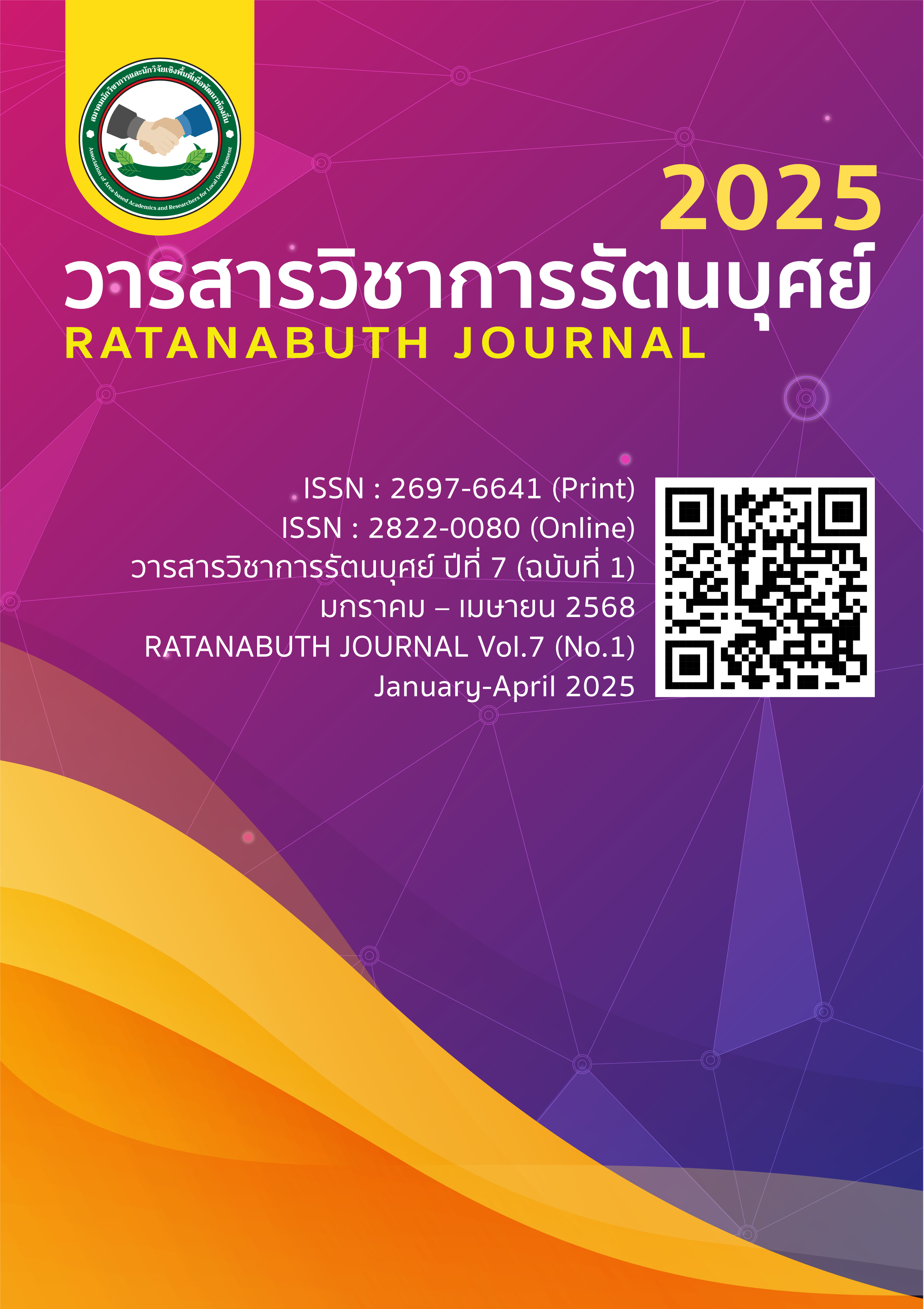Artistic Resource management: A case study of participation in Sam Chuk Market, Suphan Buri Province Artistic Resource management: A case study of participation in Sam Chuk Market, Suphan Buri Province
Main Article Content
Abstract
The country's cultural areas also have a lot of artistic resources. If there is still a lack of management that will bring benefits to the community As an example, Sam Chuk Market has artistic resources. and has managed to win world-class awards in the past Therefore, it is a model area for other communities to use. The purpose of this research to study and analyze data History Assess the value of artistic resources that are being used in Sam Chuk Market. to analyze Participation in the management of artistic resources in Sam Chuk Market and to propose a participatory art heritage management model. It is a model for other cultural resources.
The results of the study found that 1) The history began before the year 1914. There was a trading community that formed on the opposite side of Wat Sam Chuk. From there it was moved to Ban Sam Peng until 1914, it became the Sam Chuk Market community. A hundred years have passed. The community has emerging outstanding artistic resources. At first, the City Pillar Shrine was built at the same time as the market. Later, during the economic crisis, conservation management of shop buildings began. Build a museum, make a talking house, and post-COVID-19 There are important artistic activities: street art work. All events bring out cultural capital which has cultural value. 2) The analysis of participation in the construction of the City Pillar Shrine, building conservation, and the development of the museum and the "Talking House" shows that all activities involved collaborative efforts. These large-scale projects required extended timeframes, participation from various organizations, and specific expertise. The street art project was supported by educational institutions specializing in the arts and followed a participatory process based on theoretical frameworks. 3) The proposed model consists of three forms: 1) value assessment based on local beliefs, with community participation in preserving cultural identity. 2) Conservation of shop buildings, transforming them into museums or “Talking Houses,” utilizing tangible cultural capital and requiring specialized knowledge. 3) Interpretation of intangible cultural heritage from past ways of life into value through artistic representations, with participation from educational institutions specializing in the arts.
Article Details

This work is licensed under a Creative Commons Attribution-NonCommercial-NoDerivatives 4.0 International License.
References
สุนทรภู่.(2512).โครงนิราศสุพรรณ.กรุงเทพฯ: ศิวพร.
ธนิก เลิศชาญฤทธิ์. (2554). การจัดการทรัพยากรวัฒนธรรม. กรุงเทพฯ: ศูนย์มานุษยวิทยาสิรินธร (องค์การมหาชน).
ปรัชญา เวสารัชช์. (2528). การมีส่วนร่วมของประชาชนในกิจกรรมเพื่อพัฒนาชนบท. กรุงเทพฯ: สถาบันไทยคดีศึกษา มหาวิทยาลัยธรรมศาสตร์.
พรรณงาม เง่าธรรมสาร, ปรีดา คงแป้น. (2552). ย้อนมอง...สามชุกตลาดร้อยปี...กว่าจะถึงวันนี้. มปพ.
พรรณวลัย คีรีวงศ์วัฒนา, สมหมาย แจ่มกระจ่าง. (2555). การจัดการทรัพยากรทางวัฒนธรรม: การอนุรักษ์จิตรกรรมฝาผนังในภาคตะวันออก.วารสารการศึกษาและพัฒนาสังคม, 8(1), 33–46.
พิชัย สดภิบาล. (2565). ทิศทางการพัฒนาตลาดเก่าในเชิงอนุรักษ์เพื่อรองรับประชาคมอาเซียน. กรุงเทพฯ: โครงการตำราและเอกสารการพิมพ์ คณะครุศาสตร์อุตสาหกรรม สถาบันเทคโนโลยีเจ้าคุณทหารลาดกระบัง.
พิชัย สดภิบาล. (2567). การจัดการศิลปกรรมนิทัศน์ “7 สิ่งที่ต้องเรียนรู้จากกลยุทธ์การจัดการอย่างยั่งยืนในการมีส่วนร่วมในสังคม” (ฉบับปฐมฤกษ์). กรุงเทพฯ: คณะศิลปกรรมศาสตร์ มหาวิทยาลัยกรุงเทพธนบุรี.
พระใบฎีกาสุพจน์ ตปสีโล. (2556). ศึกษากระบวนการจัดการทรัพยากรธรรมชาติและวัฒนธรรมองค์กรชุมชนในจังหวัดอุบลราชธานี.รายงานการวิจัย. สถาบันวิจัยพุทธศาสตร์ มหาวิทยาลัยมหาจุฬาลงกรณราชวิทยาลัย.
รุจ รัตนพาหุ. (2547). แนวทางการอนุรักษ์และพัฒนาพื้นที่ชุมชนตลาดสามชุก จังหวัดสุพรรณบุรี .วิทยานิพนธ์สถาปัตยกรรมศาสตรมหาบัณฑิต. กรุงเทพฯ: จุฬาลงกรณ์มหาวิทยาลัย.
วันชัย แก้วไทรสุ่น. (2559). การบริหารจัดการตลาดน้ำดำเนินสะดวกเพื่อรองรับ AEC อย่างยั่งยืน. ใน รวมบทความศิลปะและการบริหารศิลปวัฒนธรรม (น. xx-xx). กรุงเทพฯ: องศาสบายดี.
วนิดา พึ่งสุนทร. (2552). การบริหารจัดการมรดกทางวัฒนธรรมชุมชน. กรุงเทพฯ: J-Print.
วิรัช นิภาวรรณ. (2541). บทบาทขององค์กรในท้องที่มีต่อการบริหารและการจัดการทรัพยากรธรรมชาติและสิ่งแวดล้อม: กรณีศึกษาจังหวัดอุบลราชธานี.วิทยานิพนธ์ดุษฎีบัณฑิต.ขอนแก่น: มหาวิทยาลัยขอนแก่น.
สหัทยา วิเศษ, พระครูโสภณปริยัติสุธี, & คณะ. (2563). รายงานการวิจัยการจัดการทรัพยากรวัฒนธรรมเชิงสร้างสรรค์ของกลุ่มจังหวัดล้านนา. มหาวิทยาลัยมหาจุฬาลงกรณราชวิทยาลัย วิทยาเขตพะเยา.
สักรินทร์ แซ่ภู, ณัฐวุฒิ อัศวโกวิทวงศ์, & คณะ. (2550). ย่านตลาด ๑๐๐ ปีสามชุกกับกลไกชุมชนในมิติการอนุรักษ์. กรุงเทพฯ: โครงการปฏิบัติการชุมชนและเมืองน่าอยู่ มูลนิธิชุมชนไท, สำนักงานกองทุนสนับสนุนการสร้างเสริมสุขภาพ และสถาบันพัฒนาองค์กรชุมชน (องค์การมหาชน).
สุพจน์ ตปสีโล (พระใบฎีกา). (2556). รายงานการวิจัยเรื่องศึกษากระบวนการจัดการทรัพยากรธรรมชาติและวัฒนธรรมขององค์กรชุมชนในจังหวัดอุบลราชธานี. กรุงเทพฯ: สถาบันวิจัยพระพุทธศาสตร์ มหาวิทยาลัยมหาจุฬาลงกรณราชวิทยาลัย, วิทยาเขตอุบลราชธานี.
อรุณี จำปานิล. (2550). ประวัติศาสตร์ชุมชนตลาดสามชุก จังหวัดสุพรรณบุรี ระหว่างปี พ.ศ. 2466–2544. การค้นคว้าอิสระปริญญาโท. กรุงเทพฯ: มหาวิทยาลัยศิลปากร.

